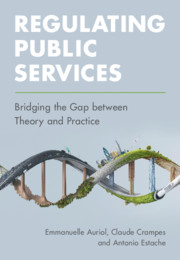Book contents
- Reviews
- Regulating Public Services
- Regulating Public Services
- Copyright page
- Contents
- Figures
- Tables
- Boxes
- Foreword
- Preface
- Acknowledgements
- Symbols
- Abbreviations
- 1 Introduction
- 2 Defining a Theoretical Normative Benchmark
- 3 Thinking Like a Monopoly about Price and Output
- 4 Regulating a Monopoly with Full Information
- 5 Regulating under Informational Constraints
- 6 Regulatory Rules to Set the Average Price
- 7 Linking Regulatory Theory to Practice through Finance
- 8 Non-Linear Pricing in Regulation
- 9 Social Concerns in Regulatory Design
- 10 Regulating Quality
- 11 On the Regulation of Investment
- 12 Regulating Multi-Product Oligopolies
- 13 Abuse of Market Power in (De)Regulated Industries
- 14 On the Relevance of Institutional Quality
- 15 Emerging Regulatory Challenges
- Bibliography
- Index
1 - Introduction
Published online by Cambridge University Press: 27 January 2022
- Reviews
- Regulating Public Services
- Regulating Public Services
- Copyright page
- Contents
- Figures
- Tables
- Boxes
- Foreword
- Preface
- Acknowledgements
- Symbols
- Abbreviations
- 1 Introduction
- 2 Defining a Theoretical Normative Benchmark
- 3 Thinking Like a Monopoly about Price and Output
- 4 Regulating a Monopoly with Full Information
- 5 Regulating under Informational Constraints
- 6 Regulatory Rules to Set the Average Price
- 7 Linking Regulatory Theory to Practice through Finance
- 8 Non-Linear Pricing in Regulation
- 9 Social Concerns in Regulatory Design
- 10 Regulating Quality
- 11 On the Regulation of Investment
- 12 Regulating Multi-Product Oligopolies
- 13 Abuse of Market Power in (De)Regulated Industries
- 14 On the Relevance of Institutional Quality
- 15 Emerging Regulatory Challenges
- Bibliography
- Index
Summary
Regulated services represent between 14% and 26% of households’ expenditures in all economies and are costly to operate and maintain. They demand heavy investments for extensive periods of time. Funding them is a challenge: investment needs in infrastructure average 1– 2% of GDP, and 4– 8% of GDP in developing economies. The technological characteristics of these services justify their production by monopolies or quasi-monopolies. Moreover, their demand being inelastic, there is a risk of abuse of market power, which drives the original case for the regulation of the price of these services. When setting them, the regulator needs to address multiple goals: financial or fiscal viability, efficiency, equity, institutional viability and political viability. It implies trade-offs, which reflects the fact that regulation is not only an economic decision but also a political one. It needs to account for the specific institutional context in which the decision is taken. For many of the key decisions, economic theory provides useful guidelines, but in some dimensions, theory still has some way to go to become fully operational in the practice of regulation. This book aims to bridge part of this gap.
Keywords
Information
- Type
- Chapter
- Information
- Regulating Public ServicesBridging the Gap between Theory and Practice, pp. 1 - 31Publisher: Cambridge University PressPrint publication year: 2021
